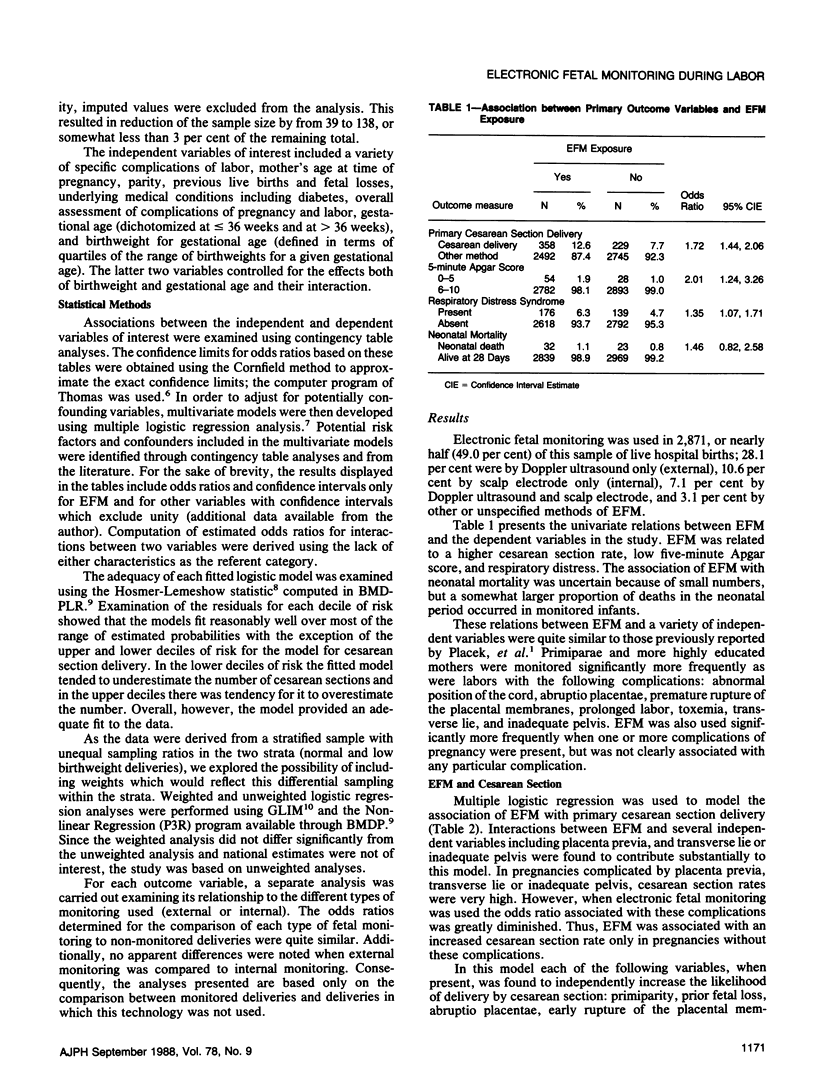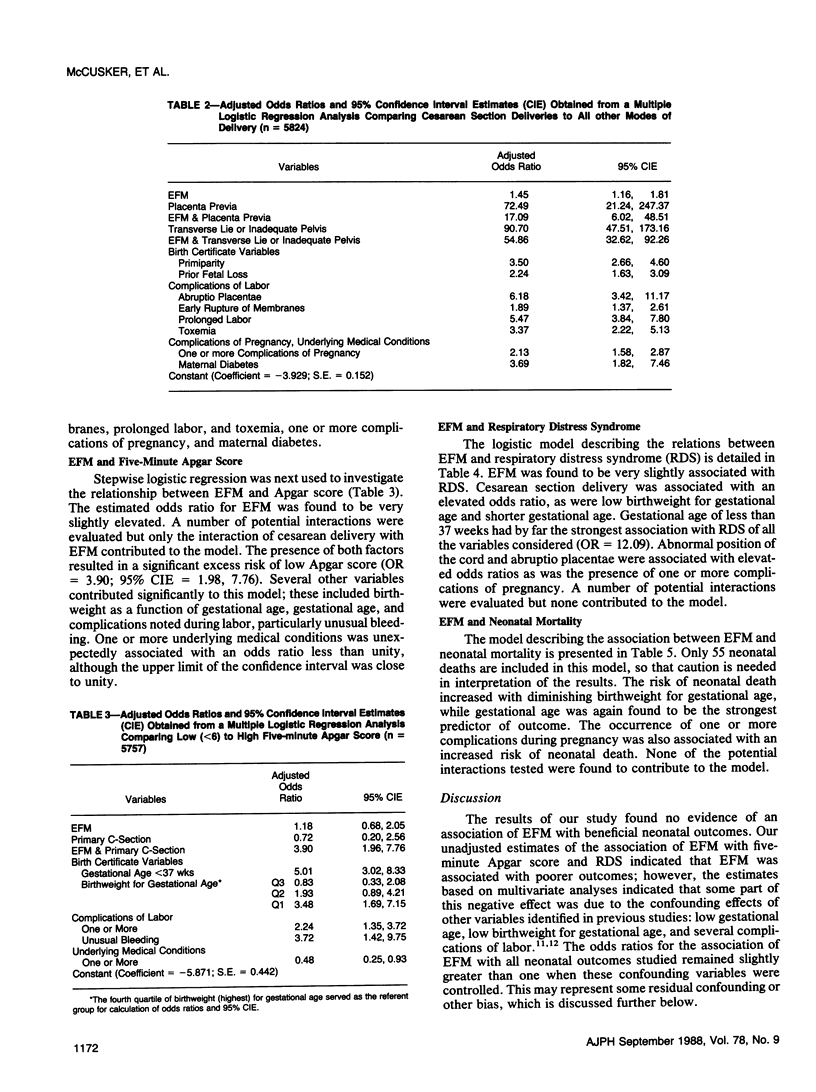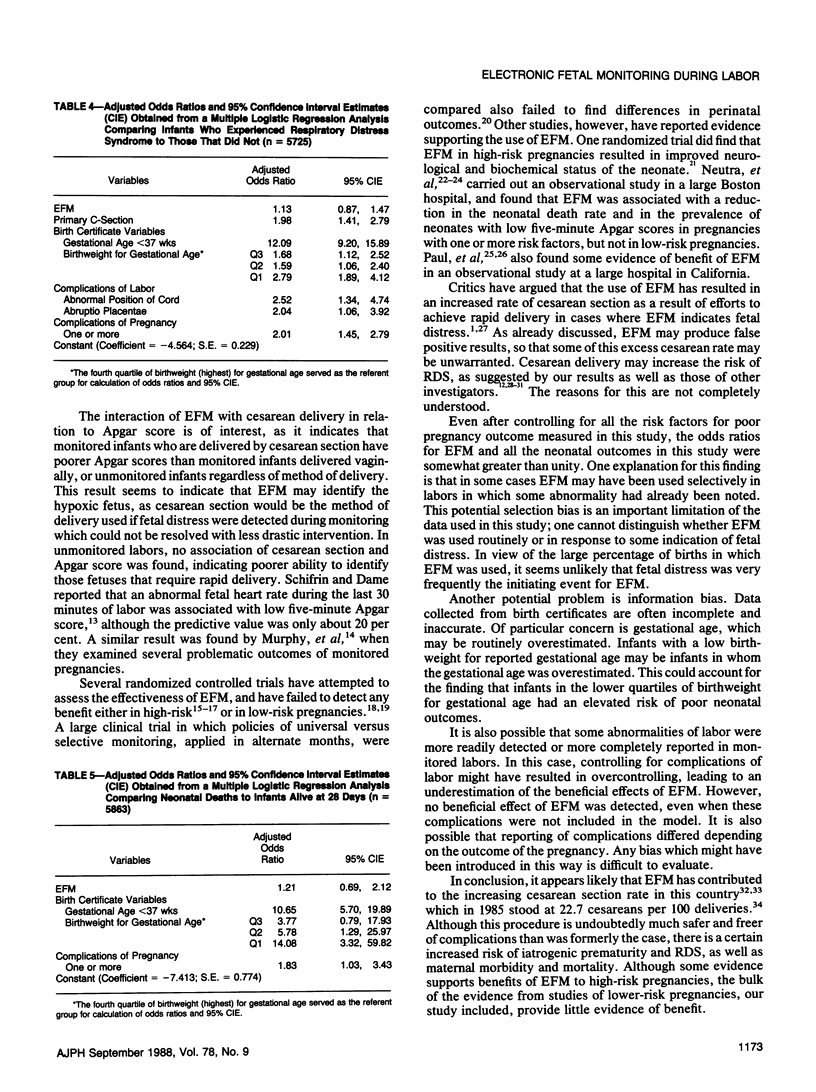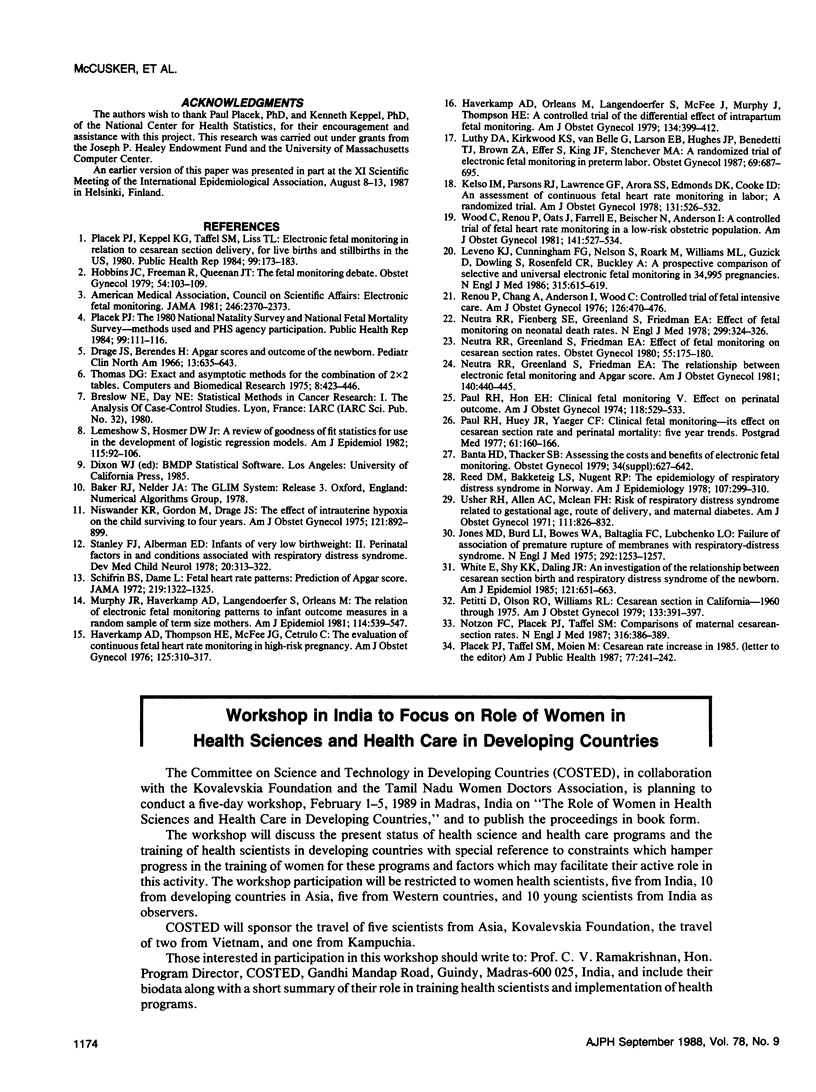Abstract
Data from the 1980 National Natality Survey by the National Center for Health Statistics were used to assess the relation of electronic fetal monitoring (EFM) during labor with cesarean section rates and neonatal morbidity and mortality. In univariate analyses, EFM was associated with higher cesarean section rates, lower five-minute Apgar scores, and a higher rate of respiratory distress. Logistic regression analysis controlling for other risk factors for poor neonatal outcome indicated that the association of EFM with higher cesarean section rates persisted (odds ratio 1.45, 95% CI 1.16, 1.81), except in certain pregnancies at very high risk for cesarean section. EFM was associated with an Apgar score less than 6 at five minutes only if delivery was by cesarean section. EFM was not found to be independently associated with respiratory distress. Neither univariate nor multivariate analyses found an association of EFM with neonatal mortality. These results suggest that EFM may identify hypoxic infants, who are frequently delivered by cesarean section. The lack of association of EFM with beneficial neonatal outcomes is consistent either with lack of effect of EFM or with uncontrolled selection bias.
Full text
PDF




Selected References
These references are in PubMed. This may not be the complete list of references from this article.
- Banta H. D., Thacker S. B. Assessing the costs and benefits of electronic fetal monitoring. Obstet Gynecol Surv. 1979 Aug;34(8):627–642. doi: 10.1097/00006254-197908000-00026. [DOI] [PubMed] [Google Scholar]
- Drage J. S., Berendes H. Apgar scores and outcome of the newborn. Pediatr Clin North Am. 1966 Aug;13(3):637–643. [PubMed] [Google Scholar]
- Haverkamp A. D., Orleans M., Langendoerfer S., McFee J., Murphy J., Thompson H. E. A controlled trial of the differential effects of intrapartum fetal monitoring. Am J Obstet Gynecol. 1979 Jun 15;134(4):399–412. doi: 10.1016/s0002-9378(16)33082-4. [DOI] [PubMed] [Google Scholar]
- Haverkamp A. D., Thompson H. E., McFee J. G., Cetrulo C. The evaluation of continuous fetal heart rate monitoring in high-risk pregnancy. Am J Obstet Gynecol. 1976 Jun 1;125(3):310–320. doi: 10.1016/0002-9378(76)90565-2. [DOI] [PubMed] [Google Scholar]
- Hobbins J. C., Freeman R., Queenan J. T. The fetal monitoring debate. Obstet Gynecol. 1979 Jul;54(1):103–109. doi: 10.1097/00006250-197907000-00023. [DOI] [PubMed] [Google Scholar]
- Jones M. D., Jr, Burd L. I., Bowes W. A., Jr, Battaglia F. C., Lubchenco L. O. Failure of association of premature rupture of membranes with respiratory-distress syndrome. N Engl J Med. 1975 Jun 12;292(24):1253–1257. doi: 10.1056/NEJM197506122922401. [DOI] [PubMed] [Google Scholar]
- Kelso I. M., Parsons R. J., Lawrence G. F., Arora S. S., Edmonds D. K., Cooke I. D. An assessment of continuous fetal heart rate monitoring in labor. A randomized trial. Am J Obstet Gynecol. 1978 Jul 1;131(5):526–532. doi: 10.1016/0002-9378(78)90114-x. [DOI] [PubMed] [Google Scholar]
- Lemeshow S., Hosmer D. W., Jr A review of goodness of fit statistics for use in the development of logistic regression models. Am J Epidemiol. 1982 Jan;115(1):92–106. doi: 10.1093/oxfordjournals.aje.a113284. [DOI] [PubMed] [Google Scholar]
- Leveno K. J., Cunningham F. G., Nelson S., Roark M., Williams M. L., Guzick D., Dowling S., Rosenfeld C. R., Buckley A. A prospective comparison of selective and universal electronic fetal monitoring in 34,995 pregnancies. N Engl J Med. 1986 Sep 4;315(10):615–619. doi: 10.1056/NEJM198609043151004. [DOI] [PubMed] [Google Scholar]
- Luthy D. A., Shy K. K., van Belle G., Larson E. B., Hughes J. P., Benedetti T. J., Brown Z. A., Effer S., King J. F., Stenchever M. A. A randomized trial of electronic fetal monitoring in preterm labor. Obstet Gynecol. 1987 May;69(5):687–695. [PubMed] [Google Scholar]
- Murphy J. R., Haverkamp A. D., Langendoerfer S., Orleans M. The relation of electronic fetal monitoring patterns to infant outcome measures in a random sample of term size infants born to high risk mothers. Am J Epidemiol. 1981 Oct;114(4):539–547. doi: 10.1093/oxfordjournals.aje.a113219. [DOI] [PubMed] [Google Scholar]
- Neutra R. R., Fienberg S. E., Greenland S., Friedman E. A. Effect of fetal monitoring on neonatal death rates. N Engl J Med. 1978 Aug 17;299(7):324–326. doi: 10.1056/NEJM197808172990702. [DOI] [PubMed] [Google Scholar]
- Neutra R. R., Greenland S., Friedman E. A. Effect of fetal monitoring on cesarean section rates. Obstet Gynecol. 1980 Feb;55(2):175–180. [PubMed] [Google Scholar]
- Neutra R. R., Greenland S., Friedman E. A. The relationship between electronic fetal monitoring and Apgar score. Am J Obstet Gynecol. 1981 Jun 15;140(4):440–445. doi: 10.1016/0002-9378(81)90042-9. [DOI] [PubMed] [Google Scholar]
- Niswander K. R., Gordon M., Drage J. S. The effect of intrauterine hypoxia on the child surviving to 4 years. Am J Obstet Gynecol. 1975 Apr 1;121(7):892–899. doi: 10.1016/0002-9378(75)90906-0. [DOI] [PubMed] [Google Scholar]
- Notzon F. C., Placek P. J., Taffel S. M. Comparisons of national cesarean-section rates. N Engl J Med. 1987 Feb 12;316(7):386–389. doi: 10.1056/NEJM198702123160706. [DOI] [PubMed] [Google Scholar]
- Paul R. H., Hon E. H. Clinical fetal monitoring. V. Effect on perinatal outcome. Am J Obstet Gynecol. 1974 Feb 15;118(4):529–533. doi: 10.1016/s0002-9378(16)33695-x. [DOI] [PubMed] [Google Scholar]
- Paul R. H., Huey J. R., Jr, Yaeger C. F. Clinical fetal monitoring: its effect on cesarean section rate and perinatal mortality: five-year trends. Postgrad Med. 1977 Apr;61(4):160–166. doi: 10.1080/00325481.1977.11714552. [DOI] [PubMed] [Google Scholar]
- Petitti D., Olson R. O., Williams R. L. Cesarean section in California--1960 through 1975. Am J Obstet Gynecol. 1979 Feb 15;133(4):391–397. doi: 10.1016/0002-9378(79)90058-9. [DOI] [PubMed] [Google Scholar]
- Placek P. J., Keppel K. G., Taffel S. M., Liss T. L. Electronic fetal monitoring in relation to cesarean section delivery, for live births and stillbirths in the U.S., 1980. Public Health Rep. 1984 Mar-Apr;99(2):173–183. [PMC free article] [PubMed] [Google Scholar]
- Placek P. J., Taffel S. M., Moien M. Cesarean rate increases in 1985. Am J Public Health. 1987 Feb;77(2):241–242. doi: 10.2105/ajph.77.2.241-a. [DOI] [PMC free article] [PubMed] [Google Scholar]
- Placek P. J. The 1980 National Natality Survey and National Fetal Mortality Survey--methods used and PHS agency participation. Public Health Rep. 1984 Mar-Apr;99(2):111–116. [PMC free article] [PubMed] [Google Scholar]
- Reed D. M., Bakketeig L. S., Nugent R. P. The epidemiology of respiratory distress syndrome in Norway. Am J Epidemiol. 1978 Apr;107(4):299–310. doi: 10.1093/oxfordjournals.aje.a112545. [DOI] [PubMed] [Google Scholar]
- Renou P., Chang A., Anderson I., Wood C. Controlled trial of fetal intensive care. Am J Obstet Gynecol. 1976 Oct 15;126(4):470–476. doi: 10.1016/0002-9378(76)90641-4. [DOI] [PubMed] [Google Scholar]
- Schifrin B. S., Dame L. Fetal heart rate patterns. Prediction of Apgar score. JAMA. 1972 Mar 6;219(10):1322–1325. [PubMed] [Google Scholar]
- Stanley F. J., Alberman E. D. Infants of very low birthweight. II: Perinatal factors in and conditions associated with respiratory distress syndrome. Dev Med Child Neurol. 1978 Jun;20(3):313–322. doi: 10.1111/j.1469-8749.1978.tb15221.x. [DOI] [PubMed] [Google Scholar]
- Thomas D. G. Exact and asymptotic methods for the combination of 2 times 2 tables. Comput Biomed Res. 1975 Oct;8(5):423–446. doi: 10.1016/0010-4809(75)90048-8. [DOI] [PubMed] [Google Scholar]
- Usher R. H., Allen A. C., McLean F. H. Risk of respiratory distress syndrome related to gestational age, route of delivery, and maternal diabetes. Am J Obstet Gynecol. 1971 Nov;111(6):826–832. doi: 10.1016/0002-9378(71)90495-9. [DOI] [PubMed] [Google Scholar]
- White E., Shy K. K., Daling J. R. An investigation of the relationship between cesarean section birth and respiratory distress syndrome of the newborn. Am J Epidemiol. 1985 May;121(5):651–663. doi: 10.1093/aje/121.5.651. [DOI] [PubMed] [Google Scholar]
- Wood C., Renou P., Oats J., Farrell E., Beischer N., Anderson I. A controlled trial of fetal heart rate monitoring in a low-risk obstetric population. Am J Obstet Gynecol. 1981 Nov 1;141(5):527–534. doi: 10.1016/s0002-9378(15)33273-7. [DOI] [PubMed] [Google Scholar]


